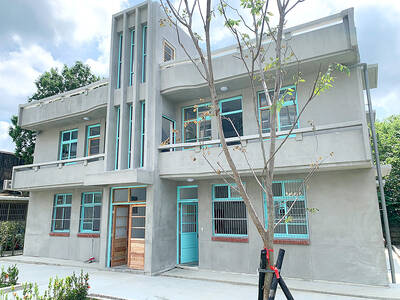In contrast to the professionally flown and technically advanced military aircraft that wowed the crowds at Taoyuan Airbase two weeks ago, some more basic forms of aviation will be on display this weekend at the inaugural Taiwan Birdman Competition (台灣鳥人大賽).
Taiwan's aeronautical buffs will have to the opportunity to see 70 of the nation's maddest pilots as they attempt to flout gravitational pull in homemade flying machines when the event touches (crashes?) down at the Weifeng canal in Er Chung.

PHOTO: AP
Organized by the Taipei County Government (台北縣政府) and sponsored by the Hontai Life insurance company (宏泰人壽), the Taiwan Birdman Competition is based on the UK's annual International Bognor Birdman competition, at which scores of amateur aviators leap off Bognor Regis pier in an attempt to defy gravity, strapped to wacky homemade flying machines.
First held in 1971 and originally known as the Birdman Rally, the now famous UK event was initially held in the little-known West Sussex seaside town of Selsey. Moving to the nearby "resort" town of Bognor in 1978, the event has since become something of an international spectacle. It attracts media interest from around the world and was watched by a record breaking 30,000 spectators last year.
The competitors have, over the years, been dressed up as everything and everyone from the Pope to a doughnut. They usually fail to fly great distances and the UK record, which was set in 1992 and remains unbeaten, is just 89.2m.
A good-humored charity event, rather than a serious sporting competition, requirements for the UK event still stipulate that competitors eligible for prizes must fly at least 46m. Organizers of the Taiwan Birdman Competition don't expect any of the participants to fly that far and have instead set the minimum distance of 10m, at which competitors are eligible for the chance to take the top prize.
The rather short distance shouldn't distract participants from flying further, however. The pilots of the 70 weird and wonderful flying contraptions who will leap off a specially constructed tower into the Weifeng canal tomorrow are all vying for a prize of NT$190,000, plus an opportunity to take part in next year's International Bognor Birdman competition in the UK. Second and third place in the competition will win cash prizes of NT$100,000 and NT$50,000 respectively.
Not that flying the furthest is the only prize on offer tomorrow. In order to ensure that participants create the most outlandish flying contraptions imaginable, organizers have included an additional 10 categories in which contestants can compete to win prizes. These include the Most Insane Design, the Best Design, the Funniest Design, an award for the best team design and a special award for the Most Popular Design, which will be chosen by the spectators.
Although organizers are keeping tight-lipped in regards as to what oddities spectators can expect to see taking to skies tomorrow, local media outlets have already chosen a favorite. Dubbed "Dangerous Insect" (蟲蟲危機) by its student design team, the winged contrivance has been taken on extensive land trials in recent weeks -- under the gaze of TV cameras -- but it will, along with the 70 other outlandish homemade flying oddities, face the ultimate test tomorrow afternoon when its pilot leaps head-first off a tower and over the Weifeng canal.
Performance notes:
What: Taiwan Birdman Competition (
Where: Er Chung Weifeng canal (
When: 1pm, Saturday, Aug. 28

June 2 to June 8 Taiwan’s woodcutters believe that if they see even one speck of red in their cooked rice, no matter how small, an accident is going to happen. Peng Chin-tian (彭錦田) swears that this has proven to be true at every stop during his decades-long career in the logging industry. Along with mining, timber harvesting was once considered the most dangerous profession in Taiwan. Not only were mishaps common during all stages of processing, it was difficult to transport the injured to get medical treatment. Many died during the arduous journey. Peng recounts some of his accidents in

“Why does Taiwan identity decline?”a group of researchers lead by University of Nevada political scientist Austin Wang (王宏恩) asked in a recent paper. After all, it is not difficult to explain the rise in Taiwanese identity after the early 1990s. But no model predicted its decline during the 2016-2018 period, they say. After testing various alternative explanations, Wang et al argue that the fall-off in Taiwanese identity during that period is related to voter hedging based on the performance of the Democratic Progressive Party (DPP). Since the DPP is perceived as the guardian of Taiwan identity, when it performs well,

A short walk beneath the dense Amazon canopy, the forest abruptly opens up. Fallen logs are rotting, the trees grow sparser and the temperature rises in places sunlight hits the ground. This is what 24 years of severe drought looks like in the world’s largest rainforest. But this patch of degraded forest, about the size of a soccer field, is a scientific experiment. Launched in 2000 by Brazilian and British scientists, Esecaflor — short for “Forest Drought Study Project” in Portuguese — set out to simulate a future in which the changing climate could deplete the Amazon of rainfall. It is

Artifacts found at archeological sites in France and Spain along the Bay of Biscay shoreline show that humans have been crafting tools from whale bones since more than 20,000 years ago, illustrating anew the resourcefulness of prehistoric people. The tools, primarily hunting implements such as projectile points, were fashioned from the bones of at least five species of large whales, the researchers said. Bones from sperm whales were the most abundant, followed by fin whales, gray whales, right or bowhead whales — two species indistinguishable with the analytical method used in the study — and blue whales. With seafaring capabilities by humans